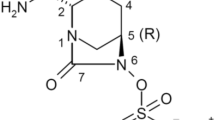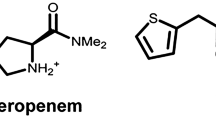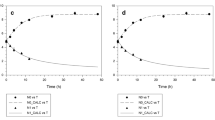Abstract
Due to limited treatment options for carbapenem-resistant Acinetobacter baumannii (CR-AB) infections, antibiotic combinations are commonly used. In this study, we explored the potential efficacy of meropenem-sulbactam combination (MEM/SUL) against CR-AB. The checkerboard method was used to screen for synergistic activity of MEM/SUL against 50 clinical CR-AB isolates. Subsequently, time-kill studies against two CR-AB isolates were performed. Time-kill data were described using a semi-mechanistic pharmacokinetic/pharmacodynamic (PK/PD) model. Subsequently, Monte Carlo simulations were performed to estimate the probability of 2-log kill, 1-log kill or stasis at 24-h following combination therapy. The MEM/SUL demonstrated synergy against 28/50 isolates. No antagonism was observed. The MIC50 and MIC90 of MEM/SUL were decreased fourfold, compared to the monotherapy MIC. In the time-kill studies, the combination displayed synergistic killing against both isolates at the highest clinically achievable concentrations. At concentrations equal to the fractional inhibitory concentration, synergism was observed against one isolate. The PK/PD model adequately delineated the data and the interaction between meropenem and sulbactam. The effect of the combination was driven by sulbactam, with meropenem acting as a potentiator. The simulations of various dosing regimens revealed no activity for the monotherapies. At best, the MEM/SUL regimen of 2 g/4 g every 8 h demonstrated a probability of target attainment of 2-log10 kill at 24 h of 34%. The reduction in the MIC values and the achievement of a moderate PTA of a 2-log10 reduction in bacterial burden demonstrated that MEM/SUL may potentially be effective against some CR-AB infections.




Similar content being viewed by others
Availability of data and materials
The datasets generated and/or analysed during the current study are not publicly available but are available from the corresponding author on reasonable request.
Abbreviations
- CR-AB:
-
carbapenem-resistant Acinetobacter baumannii
- MEM/SUL:
-
meropenem and sulbactam combination
- PTA:
-
probability of target attainment
- PK/PD:
-
pharmacokinetic/pharmacodynamic
- MIC:
-
minimum inhibitory concentration
- MIC50 :
-
MIC required to inhibit the growth of 50% of isolates
- MIC90 :
-
MIC required to inhibit the growth of 90% of isolates
- %fT>MIC:
-
percentage of unbound drug concentration remaining above the MIC during a dosing interval
- PBP:
-
penicillin-binding protein
- CI:
-
confidence interval
- OR:
-
odds ratio
- RR:
-
risk ratio
- UQCCR:
-
the University of Queensland Centre for Clinical Research
- CA-MH:
-
cation-adjusted Mueller-Hinton
- CLSI:
-
Clinical and Laboratory Standards Institute
- FICI:
-
fractional inhibitory concentration index
- CLCR :
-
creatinine clearance
- BMI:
-
body mass index
- q8h:
-
every 8 h
- CFUs and CFUr :
-
bacterial burden for the sensitive and resistant bacterial subpopulations, respectively
- Kgs and Kgr :
-
growth rate constant for the sensitive and resistant bacterial subpopulations, respectively
- Bmax:
-
maximal bacterial burden
- EmaxM and EmaxS :
-
the maximum rate of meropenem- and sulbactam-mediated bacterial killing, respectively
- C M and C S :
-
concentration of meropenem and sulbactam, respectively
- H M and H S :
-
power parameter for meropenem and sulbactam effect on both subpopulations, respectively
- EC50Ms and EC50Ss :
-
meropenem and sulbactam concentration for which effect is 50% on the sensitive subpopulation, respectively
- EC50Mr and EC50Sr :
-
meropenem and sulbactam concentration for which effect is 50% on the resistant subpopulation, respectively
- INTSM :
-
maximum fractional change of the EC50Ss and EC50Sr caused by meropenem
- HISM :
-
power parameter for meropenem potentiation of sulbactam effect
- EC50INTsm :
-
meropenem concentration needed to achieve 50% of INTSM
References
Oo C, Sy SK (2018) Fixed-dose combinations: a potential means to boost drug development for selected drugs. Drug Discov Today 23(3):457
Li T, Sheng M, Gu T, Zhang Y, Yirepanjiang A, Li Y (2018) In vitro assessment of cefoperazone-sulbactam based combination therapy for multidrug-resistant Acinetobacter baumannii isolates in China. J Thorac Dis 10(3):1370
Temocin F, Erdinc FS, Tulek N, Demirelli M, Ertem G, Kinikli S, Koksal E (2015) Synergistic effects of sulbactam in multi-drug-resistant Acinetobacter baumannii. Braz J Microbiol 46(4):1119–1124
Lim T-P, Tan T-Y, Lee W, Sasikala S, Tan T-T, Hsu L-Y, Kwa AL (2009) In vitro activity of various combinations of antimicrobials against carbapenem-resistant Acinetobacter species in Singapore. The Journal of antibiotics 62(12):675
Lee C-H, Tang Y-F, Su L-H, Chien C-C, Liu J-W (2008) Antimicrobial effects of varied combinations of meropenem, sulbactam, and colistin on a multidrug-resistant Acinetobacter baumannii isolate that caused meningitis and bacteremia. Microbial Drug Resistance 14(3):233–237
Sun Y, Wang L, Li J, Zhao C, Zhao J, Liu M, Wang S, Lu C, Shang G, Jia Y (2014) Synergistic efficacy of meropenem and rifampicin in a murine model of sepsis caused by multidrug-resistant Acinetobacter baumannii. Eur J Pharmacol 729:116–122
Cheng A, Chuang Y-C, Sun H-Y, Sheng W-H, Yang C-J, Liao C-H, Hsueh P-R, Yang J-L, Shen N-J, Wang J-T (2015) Excess mortality associated with colistin-tigecycline compared with colistin-carbapenem combination therapy for extensively drug-resistant Acinetobacter baumannii bacteremia: a multicenter prospective observational study. Crit Care Med 43(6):1194–1204
Ye J-J, Lin H-S, Yeh C-F, Wu Y-M, Huang P-Y, Yang C-C, Huang C-T, Lee M-H (2016) Tigecycline-based versus sulbactam-based treatment for pneumonia involving multidrug-resistant Acinetobacter calcoaceticus-Acinetobacter baumannii complex. BMC Infect Dis 16(1):374
Lee Y-T, Tsao S-M, Hsueh P-R (2013) Clinical outcomes of tigecycline alone or in combination with other antimicrobial agents for the treatment of patients with healthcare-associated multidrug-resistant Acinetobacter baumannii infections. Eur J Clin Microbiol Infect Dis 32(9):1211–1220
Lin H-S, Lee M-H, Cheng C-W, Hsu P-C, Leu H-S, Huang C-T, Ye J-J (2015) Sulbactam treatment for pneumonia involving multidrug-resistant Acinetobacter calcoaceticus–Acinetobacter baumannii complex. Infectious Diseases 47(6):370–378
Batirel A, Balkan I, Karabay O, Agalar C, Akalin S, Alici O, Alp E, Altay F, Altin N, Arslan F (2014) Comparison of colistin–carbapenem, colistin–sulbactam, and colistin plus other antibacterial agents for the treatment of extremely drug-resistant Acinetobacter baumannii bloodstream infections. Eur J Clin Microbiol Infect Dis 33(8):1311–1322
Yilmaz GR, Guven T, Guner R, Tufan ZK, Izdes S, Tasyaran MA, Acikgoz ZC (2015) Colistin alone or combined with sulbactam or carbapenem against A. baumannii in ventilator-associated pneumonia. The Journal of Infection in Developing Countries 9(05):476–485
Kalin G, Alp E, Akin A, Coskun R, Doganay M (2014) Comparison of colistin and colistin/sulbactam for the treatment of multidrug resistant Acinetobacter baumannii ventilator-associated pneumonia. Infection 42(1):37–42
Paul M, Daikos GL, Durante-Mangoni E, Yahav D, Carmeli Y, Benattar YD, Skiada A, Andini R, Eliakim-Raz N, Nutman A (2018) Colistin alone versus colistin plus meropenem for treatment of severe infections caused by carbapenem-resistant Gram-negative bacteria: an open-label, randomised controlled trial. Lancet Infect Dis
Makris D, Petinaki E, Tsolaki V, Manoulakas E, Mantzarlis K, Apostolopoulou O, Sfyras D, Zakynthinos E (2018) Colistin versus colistin combined with ampicillin-sulbactam for multiresistant Acinetobacter baumannii ventilator-associated pneumonia treatment: an open-label prospective study. Indian Journal of Critical Care Medicine: Peer-reviewed, Official Publication of Indian Society of Critical Care Medicine 22(2):67. https://doi.org/10.4103/ijccm.IJCCM_302_17
Lim SMS, Naicker S, Ayfan A, Zowawi H, Roberts J, Sime F (2020) Non-polymyxin based combinations as potential alternatives in treatment against carbapenem-resistant Acinetobacter baumannii infections. Int J Antimicrob Agents:106115
Zowawi HM, Sartor AL, Sidjabat HE, Balkhy HH, Walsh TR, Al Johani SM, AlJindan RY, Alfaresi M, Ibrahim E, Al-Jardani A (2015) Molecular epidemiology of carbapenem resistant Acinetobacter baumannii in the Gulf Cooperation Council States: dominance of OXA-23-type producers. J Clin Microbiol 53(3):896–903. https://doi.org/10.1128/JCM.02784-14
Determination of minimum inhibitory concentrations (MICs) of antibacterial agents by broth dilution (2003) Clin Microbiol Infect 9(8):ix–xv. https://doi.org/10.1046/j.1469-0691.2003.00790.x
CLSI (2015) Methods for dilution antimicrobial susceptibility test for bacteria that grow aerobically; Approved Standard Tenth Edition. CLSI document M07-A10. Clinical and Laboratory Standards Institute, Wayne PA
Doern CD (2014) When does 2+ 2= 5?: a review of antimicrobial synergy testing. J Clin Microbiol 52(12):4124–4128. https://doi.org/10.1128/JCM.01121-14
Saiman L (2007) Clinical utility of synergy testing for multidrug-resistant Pseudomonas aeruginosa isolated from patients with cystic fibrosis: ‘the motion for’. Paediatr Respir Rev 8(3):249–255. https://doi.org/10.1016/j.prrv.2007.04.006
Petersen PJ, Labthavikul P, Jones CH, Bradford PA (2006) In vitro antibacterial activities of tigecycline in combination with other antimicrobial agents determined by chequerboard and time-kill kinetic analysis. J Antimicrob Chemother 57(3):573–576
Neely M, van Guilder M, Yamada W, Schumitzky A, Jelliffe R (2012) Accurate detection of outliers and subpopulations with Pmetrics, a non-parametric and parametric pharmacometric modeling and simulation package for R. Ther Drug Monit 34(4):467. https://doi.org/10.1097/FTD.0b013e31825c4ba6
Alobaid AS, Wallis SC, Jarrett P, Starr T, Stuart J, Lassig-Smith M, Mejia JL, Roberts MS, Sinnollareddy MG, Roger C, Lipman J, Roberts JA (2016) Effect of obesity on the population pharmacokinetics of fluconazole in critically ill patients. antimicrob agents. Chemother 60(11):6550–6557. https://doi.org/10.1128/aac.01088-16
Jaruratanasirikul S, Wongpoowarak W, Wattanavijitkul T, Sukarnjanaset W, Samaeng M, Nawakitrangsan M, Ingviya N (2016) Population pharmacokinetics and pharmacodynamics modeling to optimize dosage regimens of sulbactam in critically ill patients with severe sepsis caused by Acinetobacter baumannii. Antimicrob Agents Chemother 60(12):7236–7244. https://doi.org/10.1128/AAC.01669-16
Mould D, Upton R (2013) Basic concepts in population modeling, simulation, and model-based drug development—part 2: introduction to pharmacokinetic modeling methods. CPT: pharmacometrics & systems pharmacology 2(4):1–14. https://doi.org/10.1038/psp.2013.14
Goulooze SC, Völler S, Välitalo PA, Calvier EA, Aarons L, Krekels EH, Knibbe CA (2019) The influence of normalization weight in population pharmacokinetic covariate models. Clin Pharmacokinet 58(1):131–138. https://doi.org/10.1007/s40262-018-0652-7
Alobaid AS, Wallis SC, Jarrett P, Starr T, Stuart J, Lassig-Smith M, Mejia JLO, Roberts MS, Lipman J, Roberts JA (2016) Effect of obesity on the population pharmacokinetics of meropenem in critically ill patients. Antimicrob Agents Chemother 60(8):4577–4584
Clinical and Laboratory Standards Institute (2020) Performance standards for antimicrobial susceptibility testing 30th ed. Clinical and Laboratory Standards Institute. http://em100.edaptivedocs.net/dashboard.aspx. Accessed 08/06/2020
Wicha S, Chen C, Clewe O, Simonsson U (2017) A general pharmacodynamic interaction model identifies perpetrators and victims in drug interactions. Nat Commun 8:2129
Marie MAM, Krishnappa LG, Alzahrani AJ, Mubaraki MA, Alyousef AA (2015) A prospective evaluation of synergistic effect of sulbactam and tazobactam combination with meropenem or colistin against multidrug resistant Acinetobacter baumannii. Bosnian journal of basic medical sciences 15(4):24
Deveci A, Coban AY, Acicbe O, Tanyel E, Yaman G, Durupinar B (2012) In vitro effects of sulbactam combinations with different antibiotic groups against clinical Acinetobacter baumannii isolates. J Chemother 24(5):247–252. https://doi.org/10.1179/1973947812Y.0000000029
Jiang Z, He X, Li J (2018) Synergy effect of meropenem-based combinations against Acinetobacter baumannii: a systematic review and meta-analysis. Infection and drug resistance 11:1083–1095. https://doi.org/10.2147/IDR.S172137
van Dam V, Olrichs N, Breukink E (2009) Specific labeling of peptidoglycan precursors as a tool for bacterial cell wall studies. Chembiochem 10(4):617–624. https://doi.org/10.1002/cbic.200800678
Penwell WF, Shapiro AB, Giacobbe RA, Gu RF, Gao N, Thresher J, McLaughlin RE, Huband MD, DeJonge BL, Ehmann DE, Miller AA (2015) Molecular mechanisms of sulbactam antibacterial activity and resistance determinants in Acinetobacter baumannii. Antimicrob Agents Chemother 59(3):1680–1689. https://doi.org/10.1128/aac.04808-14
Papp-Wallace KM, Endimiani A, Taracila MA, Bonomo RA (2011) Carbapenems: past, present, and future. Antimicrob Agents Chemother 55(11):4943–4960. https://doi.org/10.1128/aac.00296-11
Poole K, Gilmour C, Farha MA, Parkins MD, Klinoski R, Brown ED (2018) Meropenem potentiation of aminoglycoside activity against Pseudomonas aeruginosa: involvement of the MexXY-OprM multidrug efflux system. J Antimicrob Chemother 73(5):1247–1255. https://doi.org/10.1093/jac/dkx539
Louie A, Brown D, Baluya D, Rodriquez J, Robbins N, Kurhanewicz S, Fikes S, Liu W, Drusano GL, Cirz R (2014) Interaction of drug- and granulocyte-mediated killing of pseudomonas aeruginosa in a murine pneumonia model. The Journal of Infectious Diseases 210(8):1319–1324. https://doi.org/10.1093/infdis/jiu237
Roberts JA, Lipman J (2009) Pharmacokinetic issues for antibiotics in the critically ill patient. Crit Care Med 37(3):840–851; quiz 859. https://doi.org/10.1097/CCM.0b013e3181961bff
Funding
This work was supported by the Australian National Health and Medical Research Council for a Centre of Research Excellence fund (APP1099452). JAR is funded in part by a Practitioner Fellowship (APP1117065) from the National Health and Medical Research Council of Australia. SMSL received funding from the University of Queensland Research Training Scholarship. HMZ was kindly supported by the Marchant Foundation Fellowship. AJH received funding from a Griffith School of Medicine Research Higher degree scholarship.
Author information
Authors and Affiliations
Contributions
All authors contributed to the study conception and design. Material preparation and data collection were performed by SMSL. Data analysis was performed by SMSL and AJH. The first draft of the manuscript was written by SMSL and all authors commented on previous versions of the manuscript. All authors read and approved the final manuscript.
Corresponding author
Ethics declarations
Ethics approval and consent to participate
Ethical approval was waived.
Consent for publication
Not applicable.
Competing interests
The authors declare no competing interests.
Additional information
Publisher’s note
Springer Nature remains neutral with regard to jurisdictional claims in published maps and institutional affiliations.
Rights and permissions
About this article
Cite this article
Mohd Sazlly Lim, S., Heffernan, A.J., Zowawi, H.M. et al. Semi-mechanistic PK/PD modelling of meropenem and sulbactam combination against carbapenem-resistant strains of Acinetobacter baumannii. Eur J Clin Microbiol Infect Dis 40, 1943–1952 (2021). https://doi.org/10.1007/s10096-021-04252-z
Received:
Accepted:
Published:
Issue Date:
DOI: https://doi.org/10.1007/s10096-021-04252-z




